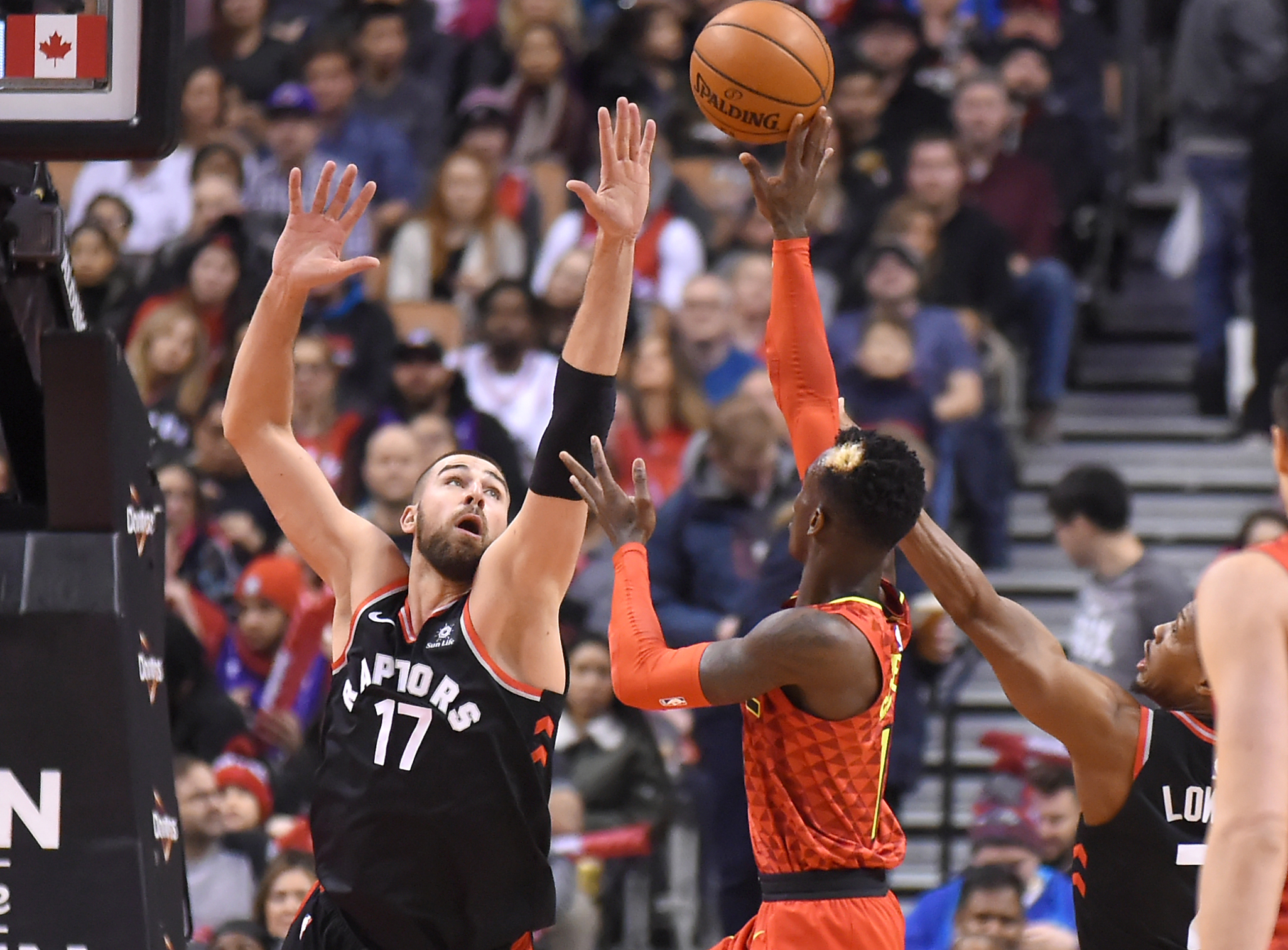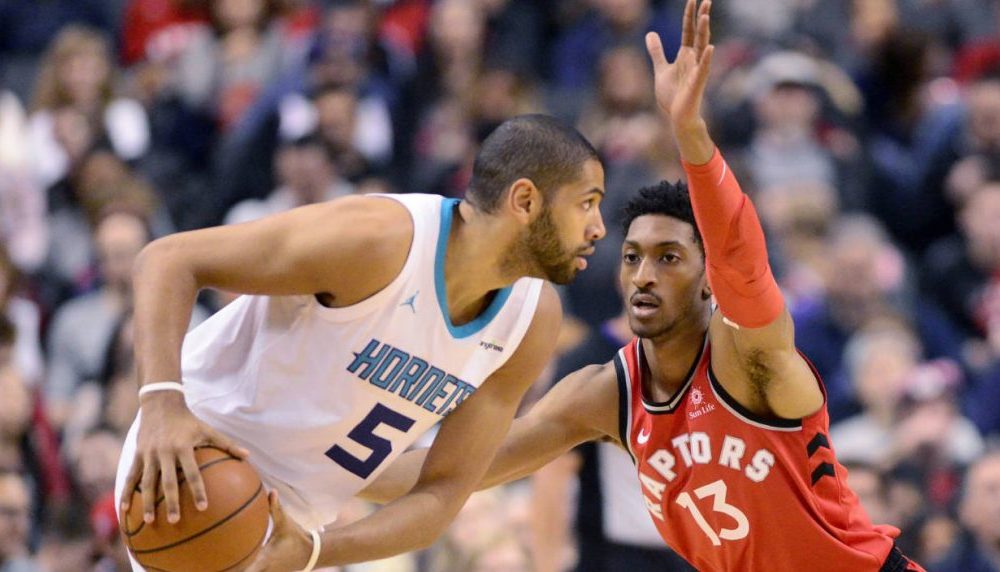For a player to improve his greatest weakness is a miracle for the team that employs him. This is the stuff of basketball fandom wet dreams; analysts all the world over slobber about players who could simply add a jumper. Case number 1: Ben Simmons. Jonas Valanciunas has always been a solid shooter, but his greatest weakness in years past has been on the defensive end. He has seemingly accomplished a miracle in 2017-18 by making his pick and roll defence playable. Teams can no longer exploit his defence every time he’s on the floor and play him out of the game. More consistent minutes allows Valanciunas to steadfastly dominate through his always-elite offensive skills: screen setting, rolling to the rim, and offensive rebounding.
So how has he improved? One important change has occurred from the top-down, in that the coaching staff seems to have finally acknowledged Valanciunas’ struggles in the pick and roll and made the scheme much milder. No longer does Valanciunas hedge high on the pick and roll; in years past he was so ineffective at corralling guards 30 feet from the rim that this strategy effectively took him out of the play entirely, allowing guards to dart around him and force defence-destroying rotations. Instead Valanciunas sinks into the paint, discouraging a lob to the roller while also staying ready to defend a drive or contest a midrange pull-up. This has been working: this year he’s in the 83rd percentile league-wide at defending the pick and roll from the big position, after ranking in the 19th percentile in 2015-16 and the 44th percentile in 2016-17.
The improvement is staggering. More than a tactical shift, Valanciunas himself seems to have become faster on his feet, more aware of the game around him, and more engaged throughout multiple defensive efforts. He has been able to consistently force misses from the league’s best jitterbugs. Here he stonewalls Kyrie Irving, staying with a fake without rising out of his defensive stance, and closing off the rim to block the shot:
He’s had great success against Bradley Beal, especially by sinking low and staying lower to the ground, always ready to spring forward and contest a midrange jumper when Beal is committed to the foolhardy plan:
He’s also blocked Kemba Walker by offering the same vigilance, awareness, and effort:
Even if he isn’t contesting a shot out of the pick and roll, Valanciunas still affects the play. He is now quick enough at moving his feet that he can stop the ball for enough time that his teammates can recover and contest the pick and roll handler’s shot:
As said above, this strategy also allows Valanciunas to prevent any pass to the roller. When active and in a proper defensive stance, Valanciunas is nigh impossible to throw the ball over:
Of course, there are downsides to the new defensive pick and roll gameplan. By playing Valanciunas so low, the Raptors frequently give open pull-up 3s to the league’s best shooters; this is because often, the best pull-up shooters double as the league’s best pick and roll handlers. Here’s an example of a shot the Raptors likely don’t want to give up, but they have little choice as a result of their gameplan. Valanciunas plays beneath a double screen on the wing, and Kyrie Irving’s defender, Kyle Lowry, is screened out of the play by a crazy-illegal Al Horford reverse bum-rush. The result is a shot that will usually result in points.
To contest these shots, the Raptors ask a huge amount from their guards. Players who are defending through the ball screen have to go over, turn the corner as tightly as possible, and return to contest the shot without fouling. That is hard, but thankfully the Raptors employ two of the league’s best at that in Delon Wright and Norman Powell. O.G. Anunoby ain’t no slouch, either.
Here’s Powell playing unorthodoxly (but well) in contesting pull-up 3s without any help from Valanciunas. On both plays, Powell spins under the screen (weird, but strangely effective) and jumps from underneath Beal to bother the shot.
The Raptors can live with those shots. Contested, pull-up 3s, even from the best shooters in the world like Bradley Beal, will not beat the Raptors. At least, not over a 7-game series. This realization has been an important for defences throughout the NBA. In fact, Dylan Murphy recently detailed for The Athletic how the Thunder have beaten the Warriors by dialing back the aggressive trapping defence that was used for the past few years to corral Steph Curry from behind the arc. The goal is to contest 3s without selling the defensive farm.
The basic concept is that yes, 3 points is more than 2, but easy 2 point shots like dunks and layups (which are created ad finitum when both pick and roll defenders trap Curry, and he finds Draymond Green on the short roll) will win any game. The Raptors have been following this defensive blueprint all season: play relatively conservative on-ball defence, switch frequently and smartly off-ball to blow up complex actions before they can begin, and contest the hell out of everything. Here’s another Murphy basketball savant, this time our own Blake, detailing for The Athletic how the Raptors’ defence is a world-beater.
And the numbers with Jonas Valanciunas on the court are working in the Raptors’ favour. Despite the more conservative on-ball scheme (but somewhat aggressive, switchy off-ball defence), the Raptors are allowing far fewer 3s per game (relative to league average) than they did in years past, when Valanciunas played higher on the pick and roll. The Raps allow the 2nd fewest 3-point shots attempted per game this year, while they were 22nd last year, 16th in 2015-16, and 13th in 2014-15, per Cleaning the Glass. The Raptors allow only 26.9% of their opponents’ shots to be 3s. With Valanciunas on the floor, that statistic sinks to 26.5%; he is an important part of their defensive strengths.
By keeping their on-ball defensive principles more conservative, the Raptors have fewer breakdowns, which means they need to help less often from the wings. With fewer defensive rotations required, Raptors defenders stick closer to shooters and funnel penetration towards the big Lithuanian in the middle. And he’s been terrific at defending the rim. Players shoot 6.7% worse from 6 feet or less with Valanciunas defending them, according to tracking stats from SAP. Valanciunas has become an honest-to-god defensive plus while he’s on the court! Because he is no longer exploitable, his defensive abilities (which have always existed) are shining. He’s an incredible defensive rebounder, a solid rim-protector, and a great post defender.
Of course, Poeltl remains better than Valanciunas at defending the pick and roll, but Valanciunas doesn’t need to be the best at every aspect of defence. He only needs to be good enough at every detail that he can’t be played off the floor by an offence focussing on his weaknesses. He’s the only elite defensive rebounder on the team, which has been proven time and again when the Raptors are killed on the offensive glass when Valanciunas sits. Defensive rebounding is a hugely underrated (by fans) defensive skill.
I wanted to work through this piece based almost solely on video instead of statistics, but it’s worth mentioning defensive rating, which is the best (but still flawed) available single defensive metric. Since January 1st, 2018, Valanciunas has a defensive rating (102.8) better than any other starter on the team. Only the bench squad offers better defensive numbers. Valanciunas’ 102.8 defensive rating in 2018 would be fourth-best in the league as a team’s season number, ranking just behind the Raptor’s stellar 102.6.
Valanciunas isn’t the best defender on the team. Over the whole season, he still has the team’s worst defensive rating among rotation players. But now, an elite defence can be built around Valanciunas on the floor. This has resulted both because of his physical and mental improvements in combination with the team’s defensive strategy no longer asking him to do the impossible. Valanciunas has gone from trade bait to playable in any defensive matchup in only a few months. That is nothing short of a miracle.



